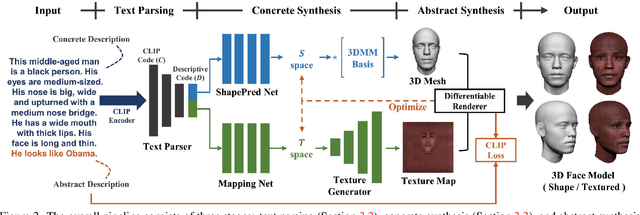Linjia Huang
EmoTalk3D: High-Fidelity Free-View Synthesis of Emotional 3D Talking Head
Aug 01, 2024



Abstract:We present a novel approach for synthesizing 3D talking heads with controllable emotion, featuring enhanced lip synchronization and rendering quality. Despite significant progress in the field, prior methods still suffer from multi-view consistency and a lack of emotional expressiveness. To address these issues, we collect EmoTalk3D dataset with calibrated multi-view videos, emotional annotations, and per-frame 3D geometry. By training on the EmoTalk3D dataset, we propose a \textit{`Speech-to-Geometry-to-Appearance'} mapping framework that first predicts faithful 3D geometry sequence from the audio features, then the appearance of a 3D talking head represented by 4D Gaussians is synthesized from the predicted geometry. The appearance is further disentangled into canonical and dynamic Gaussians, learned from multi-view videos, and fused to render free-view talking head animation. Moreover, our model enables controllable emotion in the generated talking heads and can be rendered in wide-range views. Our method exhibits improved rendering quality and stability in lip motion generation while capturing dynamic facial details such as wrinkles and subtle expressions. Experiments demonstrate the effectiveness of our approach in generating high-fidelity and emotion-controllable 3D talking heads. The code and EmoTalk3D dataset are released at https://nju-3dv.github.io/projects/EmoTalk3D.
High-Fidelity 3D Face Generation from Natural Language Descriptions
May 05, 2023



Abstract:Synthesizing high-quality 3D face models from natural language descriptions is very valuable for many applications, including avatar creation, virtual reality, and telepresence. However, little research ever tapped into this task. We argue the major obstacle lies in 1) the lack of high-quality 3D face data with descriptive text annotation, and 2) the complex mapping relationship between descriptive language space and shape/appearance space. To solve these problems, we build Describe3D dataset, the first large-scale dataset with fine-grained text descriptions for text-to-3D face generation task. Then we propose a two-stage framework to first generate a 3D face that matches the concrete descriptions, then optimize the parameters in the 3D shape and texture space with abstract description to refine the 3D face model. Extensive experimental results show that our method can produce a faithful 3D face that conforms to the input descriptions with higher accuracy and quality than previous methods. The code and Describe3D dataset are released at https://github.com/zhuhao-nju/describe3d .
 Add to Chrome
Add to Chrome Add to Firefox
Add to Firefox Add to Edge
Add to Edge